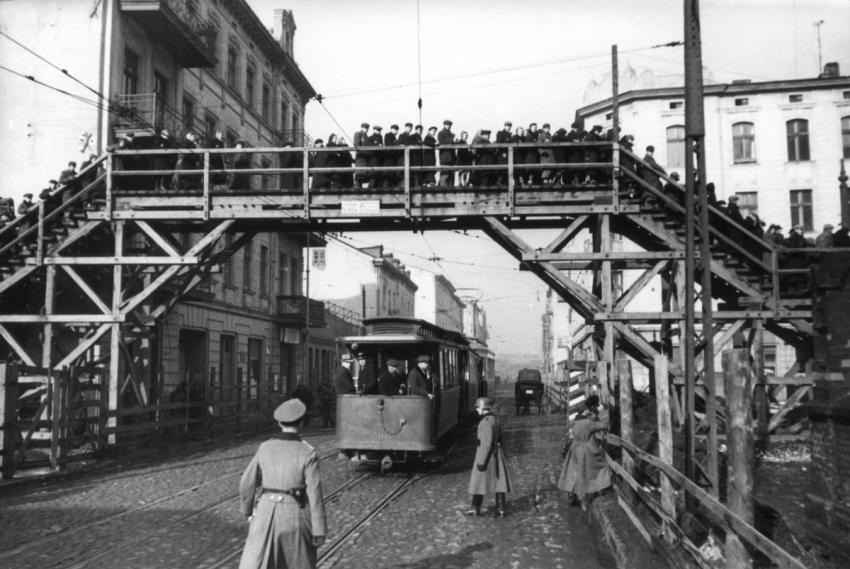At its height, the Lodz ghetto held over 200,000 Jews in a built up area spanning 2.5 square km. The fence surrounding the ghetto was completed in March 1940, and the ghetto was declared sealed in May 1940. The fence had four gates, two of them on Zgierska Street, seen in this photograph. The ghetto was divided into three areas by two major thoroughfares that passed through it and served as the links between city quarters outside the ghetto. Bridges were built over these thoroughfares, joining the three sections of the ghetto. The Jews were ordered to finance the construction of these bridges. The roads themselves were not included in the ghetto’s living space, and only Germans and Poles were allowed to use them.
Police and special SS units were responsible for guarding the ghetto borders, including Zgierska Street. Two German policemen can be seen in the photograph. The policeman wearing the helmet is a member of the Ordnungsdienst.
On the right side of the street is a photographer from the German Army's propaganda unit, filming. These units were manned by soldiers, who were subordinate to the Wehrmacht, but these units' orders came directly from Joseph Goebbels' propaganda ministry. Their work – films, photographs and articles – was sent to the German Army's high command office in Berlin. The material was sorted and censored, and forwarded to the Propaganda Ministry, which distributed it to the press.
In October 1939, the propaganda units stationed in Poland received specific orders to obtain footage from Warsaw and all the occupied territories, depicting Jews of every sort, for the purposes of antisemitic propaganda. The units were requested to report on anything interesting around them, and the ghettos therefore arose naturally as a topic to report on.
Many of the photographers were young Germans, educated in the 1930s, as were many of the target audience – those who saw the photos and films in the press and the newsreels in the cinemas. Most of them had never seen traditional Jews, since the percentage of these Jews within the total German Jewish population was only 10-15%. Most of the photographers only encountered traditional Jews after they arrived in occupied Poland. The photographs and footage taken in the ghettos and distributed in the German press reinforced the antisemitic stereotypes amongst the German public, especially the youth.
Many of the photographs were taken by official photographers working under the auspices of the Propaganda Ministry, but not only Nazis and collaborators took pictures in the ghettos. Nina Springer-Aharoni notes that there were German soldiers and civilians who photographed Jews in the ghettos out of a feeling of empathy, and not necessarily from an antisemitic perspective, such as the soldier Joe Heydecker.
Yad Vashem Photo Archives, 7261/24 – Courtesy of the German National Archive (Bundesarchiv)







